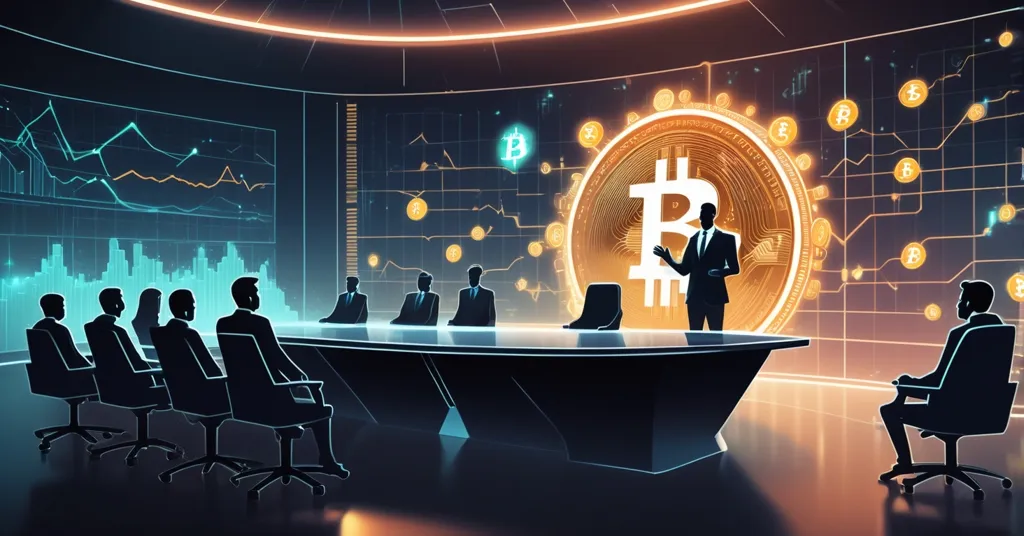Kevin Hassett as Fed Chair: Crypto Boost or Conflict of Interest Controversy?

Kevin Hassett as Fed Chair: Crypto Revolution or Conflict of Interest?
Kevin Hassett has surged ahead as the top candidate to replace Jerome Powell as Federal Reserve Chair, catching the attention of crypto investors worldwide. With President Donald Trump’s strong backing and Hassett’s deep ties to the cryptocurrency industry, his potential appointment could redefine monetary policy and digital asset regulation. But with personal stakes in the game, the question looms: is this a breakthrough for Bitcoin and blockchain, or a dangerous overlap of interests?
- Leading Contender: Hassett tops the list to succeed Powell, with a decision expected by Christmas.
- Crypto Connections: Holding over $1 million in Coinbase stock, Hassett has shaped digital asset policies.
- Double-Edged Potential: A crypto-friendly Fed could emerge, but conflicts of interest cast a shadow.
Hassett’s Rise and Trump’s Vision for the Fed
The race to replace Jerome Powell, whose term as Federal Reserve Chair concludes in May 2026, has zeroed in on Kevin Hassett, current director of the White House National Economic Council. President Trump, frustrated by Powell’s measured approach to lowering interest rates, sees Hassett as the right fit for a more aggressive economic stimulus plan. Unlike Powell’s careful steps—two rate cuts this fall with a third likely in December—Hassett has signaled urgency, pushing for immediate action based on today’s economic signals. Prediction markets like Kalshi and Polymarket reflect this momentum, giving Hassett over a 50% chance of securing the role, outpacing other finalists such as Kevin Warsh, Christopher Waller, Michelle Bowman, and BlackRock’s Rick Rieder. For more on this development, check out the latest insights on Hassett’s frontrunner status for the Fed Chair position.
For those new to the Fed’s role, the Federal Reserve is the central banking system of the United States, controlling interest rates and money supply to stabilize the economy. Its policies ripple through every financial market, including cryptocurrencies, which often react sharply to rate changes. Hassett’s potential leadership isn’t just a personnel swap; it’s a signal of a broader shift toward a pro-growth, risk-friendly environment that could directly influence how Bitcoin and other digital assets are perceived and valued. But before we pop the champagne, let’s dig into what this really means for the crypto space.
Hassett’s Monetary Vision: A Boost for Crypto Markets?
Hassett’s approach to monetary policy, often described as “dovish,” prioritizes cutting interest rates to spur economic growth. Simply put, lower rates make borrowing cheaper, encouraging spending and investment—often pushing money into higher-risk options like stocks or cryptocurrencies. For Bitcoin and altcoins, this could translate to more capital flowing into the market as investors seek bigger returns outside traditional safe bets like bonds. The Fed’s recent rate cuts have already stirred optimism, and under Hassett, we might see this trend accelerate, potentially fueling a bullish wave for digital assets.
However, it’s not all smooth sailing. Slashing rates too fast risks overheating the economy, driving up inflation. If prices for everyday goods spike, the real-world value of your Bitcoin might shrink—even if its dollar price climbs. Picture this: your BTC might soar to new heights, but if a loaf of bread costs double what it did last year, are you really ahead? It’s a gamble, and one that could dampen long-term crypto adoption if people start doubting its practical use as a store of value. Still, with Trump’s clear preference for economic stimulus over caution, Hassett’s vision aligns with a mindset that many crypto enthusiasts cheer—a “go big or go home” push that could shake up the status quo.
Crypto Ties: Boon or Bane for Digital Assets?
Beyond monetary policy, Hassett’s personal stake in the crypto world is impossible to ignore. With over $1 million invested in Coinbase, one of the largest cryptocurrency exchanges, and a paid position on its Academic and Regulatory Advisory Council (earning him over $50,000), he’s not just an observer—he’s a player. During his time in the White House, Hassett chaired a digital asset working group, influencing policies on stablecoin regulation, taxation, and even the bold idea of a Strategic Bitcoin Reserve. For newcomers, stablecoins are digital currencies like Tether (USDT) or USD Coin (USDC), pegged to stable assets like the U.S. dollar to avoid the wild price swings of Bitcoin. They’re crucial for trading and decentralized finance (DeFi), but their links to traditional banking put them under the Fed’s watchful eye.
The Strategic Bitcoin Reserve, meanwhile, is a proposal that’s got Bitcoin maximalists buzzing. The concept involves the U.S. government holding Bitcoin as a national asset, akin to gold reserves, to hedge against economic uncertainty or currency devaluation. While details remain vague—how much BTC, how it’s acquired, or who manages it—Hassett’s involvement in shaping this idea suggests he views Bitcoin as more than a speculative toy. Bitwise strategist Juan Leon captured the industry’s excitement, stating:
“A Hassett-led Fed would be strongly supportive of digital assets.”
Leon argues that Hassett’s firsthand experience and policy leanings could foster a regulatory environment that embraces innovation over restriction. For Bitcoin purists, a Fed-backed reserve could cement BTC as the ultimate decentralized store of value. For Ethereum builders and altcoin advocates, a lighter regulatory touch might let DeFi and smart contracts thrive without constant fear of a government hammer. But let’s not get carried away—there’s a flip side that’s hard to gloss over.
Conflict of Interest: A Red Flag for Crypto Oversight?
Hassett’s deep ties to Coinbase scream conflict of interest in a way that’s hard to ignore. Think of it like a referee in a soccer match owning a massive chunk of one team’s stock—can you really trust their calls won’t lean toward their wallet? The Federal Reserve doesn’t just tweak interest rates; it oversees banking rules that directly affect crypto companies, especially with stablecoins bridging digital and traditional finance. If Hassett pushes policies that favor Coinbase or the broader crypto market, skeptics will question whether it’s about public good or personal gain. This isn’t a trivial concern—the crypto space is already plagued by scams, rug pulls, and shady actors. The last thing we need is a Fed Chair perceived as too cozy with an industry crying out for fair, unbiased oversight.
Historically, the Fed has faced scrutiny for leaders with questionable financial ties—think back to past controversies where personal investments clashed with public duty. Hassett’s situation isn’t unprecedented, but it’s particularly glaring given crypto’s volatile reputation and the Fed’s growing role in regulating banking exposure to digital assets. If stablecoin frameworks loosen under his watch, benefiting firms like Coinbase, the optics could erode trust in both the Fed and the crypto sector. And let’s be real: while we champion decentralization and disruption, we can’t ignore the stench of potential favoritism here. It’s a gut punch to the idea of impartial governance.
Playing Devil’s Advocate: Does Crypto Need an Insider?
Now, let’s flip the script. Could Hassett’s insider status be exactly what crypto needs to drag the Fed kicking and screaming into the modern era? Blockchain and digital currencies aren’t a passing fad—they’re reshaping finance whether central bankers like it or not. Having a Fed Chair who actually understands Bitcoin beyond “internet magic money” could fast-track policies that balance innovation with stability. Isn’t it better to have someone with skin in the game than another disconnected bureaucrat who’d rather ban crypto than engage with it? Hassett’s Coinbase stake might raise eyebrows, but his experience could be the bridge between decentralized tech and centralized power that we’ve been waiting for.
Moreover, Trump’s broader push for deregulation and economic stimulus aligns with the ethos of disruption many of us in the crypto space hold dear. A Hassett-led Fed could champion effective accelerationism—pushing for rapid, transformative change over timid half-measures. Sure, traditional economists might balk, warning of systemic risks or market volatility (as if fiat hasn’t caused enough crashes). But isn’t it time the Fed treated Bitcoin as a serious contender rather than a rebellious punk? While Bitcoin remains the gold standard for decentralized value, Ethereum’s smart contracts and other protocols fill vital niches—Hassett might just be the guy to let them all breathe easier.
The Strategic Bitcoin Reserve: Dream or Danger?
Let’s zoom in on the Strategic Bitcoin Reserve proposal, a concept Hassett helped shape. The idea is simple yet radical: the U.S. government would stockpile Bitcoin as a strategic asset, much like it holds gold or foreign currencies. Supporters argue it’s a forward-thinking move to protect against dollar devaluation or geopolitical shocks—Bitcoin’s fixed supply and decentralized nature make it a unique hedge. Some estimates suggest a reserve could start with tens of thousands of BTC, potentially acquired through seizures (like those from criminal cases) or direct purchases, funded by federal budgets. For Bitcoin maximalists, this is the ultimate validation—a nation-state endorsing BTC as a cornerstone of financial sovereignty.
Yet, even among Bitcoin diehards, there’s unease. Centralizing large BTC holdings under government control risks undermining the very decentralization that makes Bitcoin powerful. If the U.S. hoards millions in BTC, doesn’t that create a target for hacks or political manipulation? And what happens if other nations follow suit, turning Bitcoin into a pawn in global power games? Hassett’s support for the reserve signals a crypto-friendly stance, but it also opens a Pandora’s box of questions about how far central authority should reach into a system built to escape it. This isn’t just policy—it’s a philosophical clash.
Stablecoin Regulation: A Test of Hassett’s Balance
Stablecoins are another battleground where Hassett’s influence could make or break crypto’s future. These tokens are the glue of much of the crypto economy, enabling fast, stable transactions in DeFi and trading. But their reliance on reserves—often tied to traditional banks—puts them under intense regulatory scrutiny. During his White House tenure, Hassett advocated for clearer, less punitive frameworks, arguing that overregulation stifles innovation. If he helms the Fed, we might see policies that give stablecoin issuers like Tether or Circle more leeway, potentially integrating them deeper into mainstream finance.
On the other hand, critics warn that lax rules could invite disasters—think of past stablecoin collapses like TerraUSD, which wiped out billions in value overnight. The Fed’s role isn’t to play cheerleader; it’s to protect systemic stability. If Hassett leans too far toward his crypto allies, a misstep in stablecoin oversight could trigger a chain reaction, tainting digital assets as reckless gambles. Historical data backs this caution: Bitcoin often dips after major Fed announcements, as seen post-2020 rate adjustments, reflecting how intertwined crypto is with central policy. Hassett’s challenge will be threading the needle—supporting growth without ignoring real risks.
Market Optimism vs. Hype: A Reality Check
The crypto community’s excitement over Hassett is palpable, and not without reason. His track record suggests a Fed that could prioritize digital asset growth over knee-jerk bans. But let’s cut through the noise: this isn’t a guarantee of Bitcoin hitting six figures by next Tuesday, no matter what some shills on X might scream. Responsible adoption means tempering hype with hard facts. While rate cuts and friendlier regulation could lift prices—Bitcoin surged over 60% in 2020-2021 amid low rates—macroeconomic headwinds like inflation or geopolitical unrest can just as easily tank sentiment. Hassett isn’t a magic wand; he’s a policymaker in a messy, unpredictable system.
Still, the potential for a transformative shift is real. Beyond Bitcoin, Ethereum’s smart contract ecosystem and other innovative protocols could flourish if regulatory shackles loosen. Each blockchain fills a niche—BTC as a decentralized gold, ETH as a programmable platform—that a forward-thinking Fed might finally respect. The crypto space, hungry for clarity after years of hostile or vague rules, sees Hassett as a possible turning point. Whether that optimism holds depends on how he navigates the tightrope of personal ties and public duty.
Key Questions and Takeaways
- What could Kevin Hassett’s appointment mean for Bitcoin and crypto regulation?
His ties to Coinbase and policy history point to a softer regulatory approach, potentially advancing ideas like the Strategic Bitcoin Reserve and easing burdens on digital asset firms. - How might Hassett’s push for rate cuts affect the crypto market?
Lower interest rates could drive more money into high-risk assets like Bitcoin, sparking bullish trends, though inflation risks might undercut long-term adoption. - Are conflicts of interest a serious concern with Hassett’s crypto stakes?
Yes—his $1 million Coinbase investment and advisory role raise valid doubts about impartiality, especially with the Fed’s oversight of stablecoin and banking rules. - Why is the crypto community so hopeful about a Hassett-led Fed?
His industry know-how and dovish policies suggest a leadership that could champion digital assets, favoring innovation over restriction, as Bitwise’s Juan Leon highlighted. - Could the Strategic Bitcoin Reserve backfire on decentralization?
While it validates Bitcoin’s value, government stockpiling risks centralizing control, clashing with BTC’s core ethos of freedom from authority.
As the Christmas deadline for the Fed Chair announcement approaches, the stakes for cryptocurrency couldn’t be higher. Hassett’s candidacy sits at the crossroads of monetary policy, digital innovation, and ethical scrutiny. Will he be the disruptor crypto needs to break into the mainstream, or the insider it should fear most? For Bitcoin maximalists dreaming of a national reserve, for Ethereum developers crafting the future of finance, and for every investor betting on decentralization, the answer will shape the next chapter of this financial revolution. One thing’s certain: we’re in for a wild ride, and the crypto world is watching every move.



